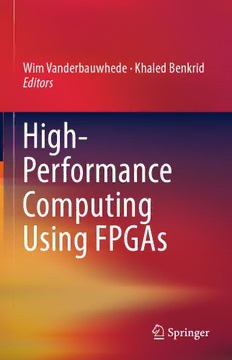
High-Performance computing using FPGAs PDF
Preview High-Performance computing using FPGAs
Wim Vanderbauwhede · Khaled Benkrid Editors High- Performance Computing Using FPGAs High-Performance Computing Using FPGAs Wim Vanderbauwhede • Khaled Benkrid Editors High-Performance Computing Using FPGAs 123 Editors WimVanderbauwhede KhaledBenkrid SchoolofComputingScience SchoolofEngineeringandElectronics UniversityofGlasgow TheUniversityofEdinburgh Glasgow,UnitedKingdom Edinburgh,UnitedKingdom ISBN978-1-4614-1790-3 ISBN978-1-4614-1791-0 (eBook) DOI10.1007/978-1-4614-1791-0 SpringerNewYorkHeidelbergDordrechtLondon LibraryofCongressControlNumber:2013932707 ©SpringerScience+BusinessMedia,LLC2013 Thisworkissubjecttocopyright.AllrightsarereservedbythePublisher,whetherthewholeorpartof thematerialisconcerned,specificallytherightsoftranslation,reprinting,reuseofillustrations,recitation, broadcasting,reproductiononmicrofilmsorinanyotherphysicalway,andtransmissionorinformation storageandretrieval,electronicadaptation,computersoftware,orbysimilarordissimilarmethodology nowknownorhereafterdeveloped.Exemptedfromthislegalreservationarebriefexcerptsinconnection with reviews or scholarly analysis or material supplied specifically for the purpose of being entered and executed on a computer system, for exclusive use by the purchaser of the work. Duplication of this publication or parts thereof is permitted only under the provisions of the Copyright Law of the Publisher’slocation,initscurrentversion,andpermissionforusemustalwaysbeobtainedfromSpringer. PermissionsforusemaybeobtainedthroughRightsLinkattheCopyrightClearanceCenter.Violations areliabletoprosecutionundertherespectiveCopyrightLaw. Theuseofgeneraldescriptivenames,registerednames,trademarks,servicemarks,etc.inthispublication doesnotimply,evenintheabsenceofaspecificstatement,thatsuchnamesareexemptfromtherelevant protectivelawsandregulationsandthereforefreeforgeneraluse. While the advice and information in this book are believed to be true and accurate at the date of publication,neithertheauthorsnortheeditorsnorthepublishercanacceptanylegalresponsibilityfor anyerrorsoromissionsthatmaybemade.Thepublishermakesnowarranty,expressorimplied,with respecttothematerialcontainedherein. Printedonacid-freepaper SpringerispartofSpringerScience+BusinessMedia(www.springer.com) Foreword Thefieldprogrammablegatearray(FPGA)wasdevelopedinthemiddleof1980s with the original intent to be a prototyping medium. The array of programmable logicblocksenabledittobereconfiguredtoanyofavarietyofcomputefunctions. As such it was an attractive vehicle for “in circuit hardware emulation” where designs could be prototyped and debugged before being committed to silicon. It wasalsoanattractiveteachingvehicleforstudentslearningcomputerdesign.Itwas withthisinmindthatIwasfirstintroducedtotheFPGAbyoneofthepioneersin thefield,RossFreeman,thefounderofXilinx(whotragicallydiedjustafewyears afterXilinx’sfounding). As the underlying silicon technology improved and the functional potential was better understood, the FPGA slowly permeated many aspects of computing. By the 1990sit was an accepted componentin most communicationstechnology, then consumer-electronics and automotive applications became apparent, and by the early 2000s the FPGA was well established in almost all areas of computing excepthighperformancecomputing(HPC).ItwouldseemthatHPCisanunlikely target for FPGAs, as the FPGA with all of its flexibility in both routing and configurationhasacleardisadvantagewhencomparedtocustomarithmeticdesign whenmeasuredintermsofanareatimepowerproduct.Ofcourse,eventhenitwas understoodthatthereweresomesmallspecializedcomputeapplicationsforwhich theFPGAcouldoffersomesignificantperformanceadvantagesmostlyinareassuch ascryptographyandspecializedarithmetic. Around 2003 there was a seismic shift in the underlying silicon technology, andMoore’slawoffrequencyscaling(processorsdoubleperformanceevery18–24 months)becameinoperativebecausethepowerdensitiesrequiredtosupporthigher frequenciescouldnotbeeconomicallysustained.Thefuturewasparallelinoneway oranother.lnHPCtheobviousapproachwastousemulticoreimplementations,but there is a problem with attempting to scale performanceby simply increasing the numberofcoresorprocessorstoexecuteanapplication.Theprogrammingmodels thatwehavedevelopedoverthepastdecadehavebeenorientedtowardsequential processingandnotparallelprocessing.Theintroductionofparadigmssuchaslayers v vi Foreword ofabstractionsthathidetheunderlyinghardwarethusmakesitdifficulttofindthe rightformofparallelismtobestexpresstheexecutionofanapplication. Still the notion of using FPGAs as a fabric to realize HPC for large classes of applicationsissurprisingtomany.Itsurelywasunforeseenadecadeago.Sowhat enablestheFPGAtomakeitsmarkinHPC?Thereareatleastthreereasons: 1. The aforementioned difficulty in achieving scalable speed up with multicore implementations. 2. While Moore’s law for frequency scaling ceased in 2003, Moore’s law on transistor density scaling is still very much active so that over the intervening decadetransistordensitieshavescaleduponmorethananorderofmagnitude. These densities enable very large FPGA configurations. An enormous number ofcellsareavailabletorealizecomplexcomputeengines.AndbecauseFPGAs necessarily operate at lower frequencies, they have not hit the power density limitsoftheCPU. 3. TheflexibilityoftheFPGAenablesthedesignertorealizealmostanycomputer configuration that can be imagined and use any form of parallelism to suit the application.Thisflexibilityprovidestheopportunitytocreateidealmachinesfor specific applications and unlike a decade ago where these applications would necessarilysmalltheynowcanbeofsignificantscope—reallylarge,important, andinterestingapplications. In a sense we have come full circle: the designer is again using the FPGA to do emulationbutnowthatemulationisnotofsomeestablishedCPUbutanemulation of an ideal machine for a particular application using techniques, representations, and processor forms unavailable to conventional processor designs. In effect the designerisemulatingthefutureofcomputinghigh-speedcomputing. Thisextraordinarybookbringstogethertheworkoftheleadingtechnologistsin this importantfield and points to the direction not only for high speed computing butalsofortheveryfutureofcomputingitself. Stanford,CA,USA MichaelJ.Flynn PaloAlto,CA,USA Preface The seamless exponential increase in computing power that scientists, engineers and computer users at large have enjoyed for decades has come to an end by the mid-2000s.Indeed, while until then, computer users could rely on computing power doublingevery 18 monthsor so simply by meansof increases in transistor integration levels and clock frequencies, with no major changes to software, physical limitations including voltage scaling and heat dissipation meant that this isnolongerpossible.Instead,thechipfabricationindustryhasturnedtomulticore chiptechnologytokeepthe“possibility”ofdoublingcomputerperformanceevery 18 months alive. However, this is just a “potential” performanceincrease and not a seamless one as applicationsoftware needsto be recodedto take full advantage of the performancepotentialof multicore technologies.Failing this, the computer industry would cease to become a growth industry as there would be no need for computer upgrades for performance sake. Instead, the industry would become a replacementindustrywherecomputersareonlyboughttoreplacefaultyones.This couldhaveseriouseconomicrepercussions;hencetheexplosionofresearchactivity inindustryandacademiainrecentyearsaimedatbridgingthesemanticgapbetween applications, traditionally written in sequential code, and hardware, increasingly parallelinarchitecture. The aforementioned semantic gap, however, is also opening a window of opportunity for niche parallel computer technologies such as field programmable gate array (FPGAs) and graphics processor units (GPUs) which have become more mainstream because the problem of parallel programminghas to be tackled for general-purpose processors anyway. FPGAs in particular have the promise of custom-hardwareperformanceandlowpower,withthesoftwarereprogrammability advantageofgeneralpurposeprocessors.Thisispreciselywhythistechnologyhas attracted a great deal of attention within the high performance computing (HPC) community, giving rise to the new discipline of high performance reconfigurable computing(HPRC). The aim of this bookis to presenta comprehensiveview of the state of the art of HPRC to existing and aspiring researchers in the field. This book is split into threemainparts:thefirstpartdealswithHPRCapplications,thesecondwithHPRC vii viii Preface architectures, and the third with HPRC tools. Each part consists of a number of contributionsfromeminentresearchersinthefield.Throughoutthebook,emphasis ismadeonopportunities,challenges,andpossiblefuturedevelopments,especially inrelationtoothertechnologiessuchasgeneral-purposemulticoreprocessorsand GPUs.Overall,wehopethatthisbookwillserveasbothareferenceandastarting pointforexistingandfutureresearchersinthefieldofHPRC. Finally,wethankallcontributors,reviewers,andSpringer’sstafffortheirefforts andperseveranceinmakingthisbookprojectareality. Glasgow,UK WimVanderbauwhede Edinburgh,UK KhaledBenkrid Contents PartI Applications High-PerformanceHardwareAccelerationofAssetSimulations .......... 3 Christian de Schryver,HenningMarxen,Stefan Weithoffer, andNorbertWehn Monte-Carlo Simulation-Based Financial Computing ontheMaxwellFPGAParallelMachine ...................................... 33 XiangTianandKhaledBenkrid Bioinformatics Applications on the FPGA-Based High-PerformanceComputerRIVYERA..................................... 81 LarsWienbrandt FPGA-AcceleratedMolecularDynamics...................................... 105 M.A.Khan,M.Chiu,andM.C.Herbordt FPGA-BasedHPRCforBioinformaticsApplications........................ 137 YoshikiYamaguchi,YasunoriOsana,MasatoYoshimi, andHideharuAmano High-PerformanceComputingforNeuroinformaticsUsingFPGA........ 177 WillX.Y.Li,RosaH.M.Chan,WeiZhang,ChiwaiYu,DongSong, TheodoreW.Berger,andRayC.C.Cheung High-PerformanceFPGA-AcceleratedReal-TimeSearch .................. 209 WimVanderbauwhede,Sai.R.Chalamalasetti,andMartinMargala High-PerformanceDataProcessingOverN-aryTrees ...................... 245 ValerySklyarovandIouliiaSkliarova FPGA-Based Systolic Computational-Memory Array forScalableStencilComputations ............................................. 279 KentaroSano ix
